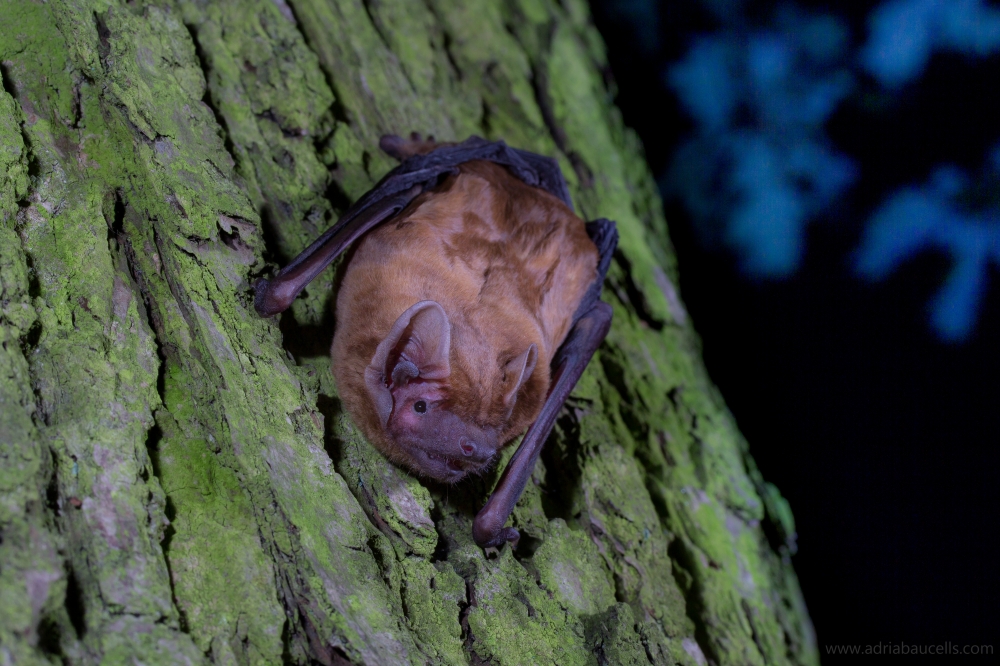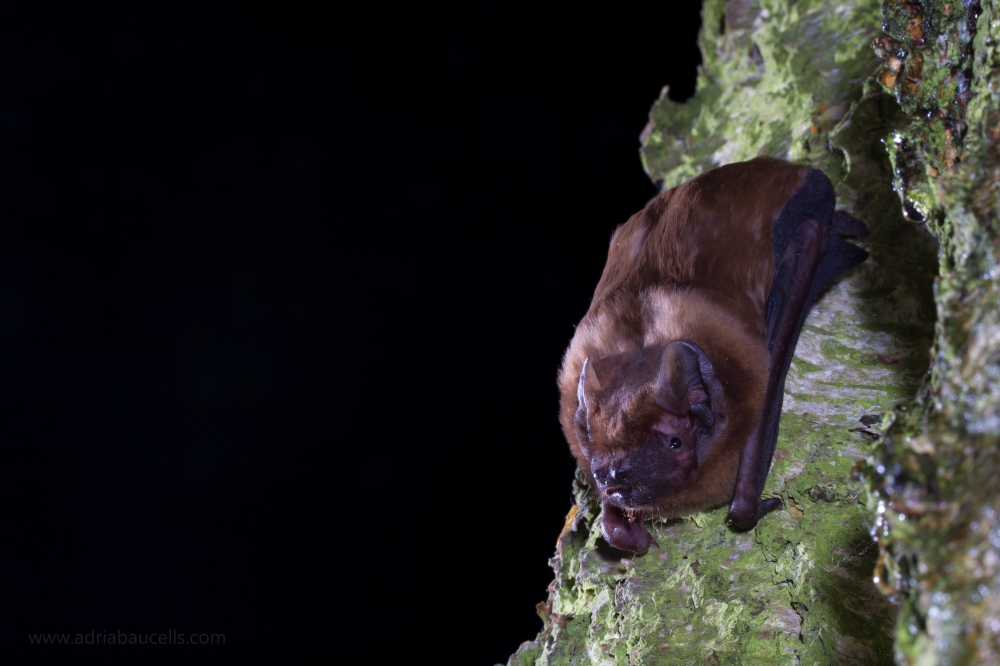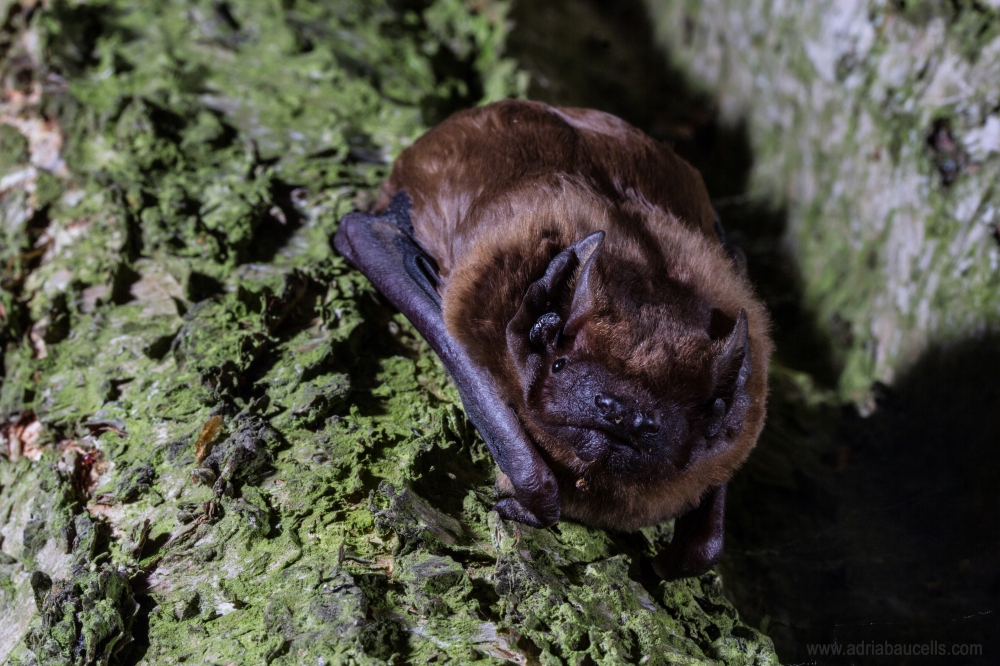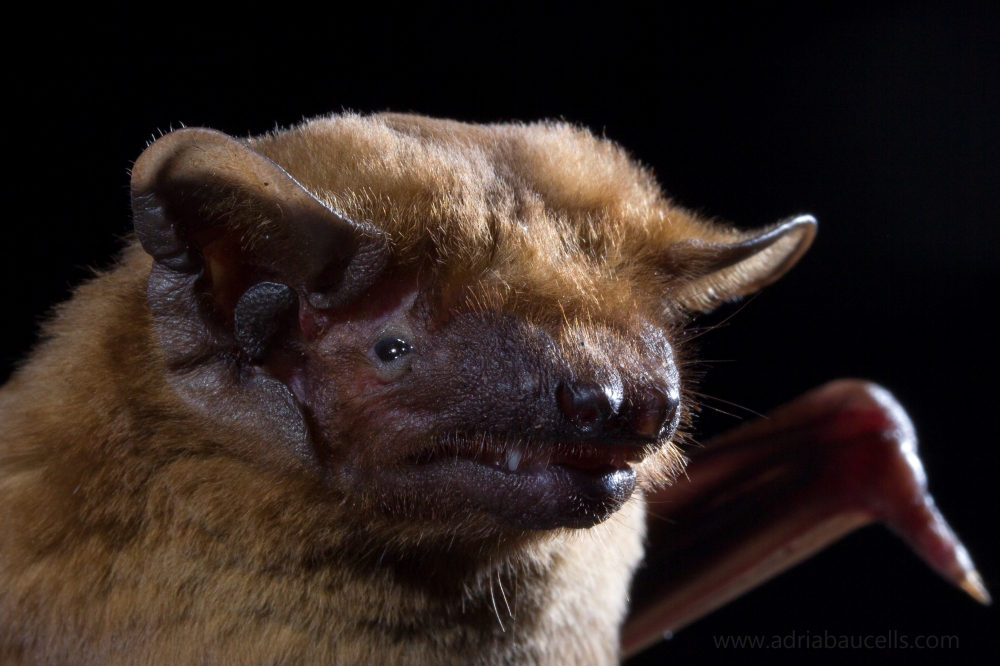Noctule bat
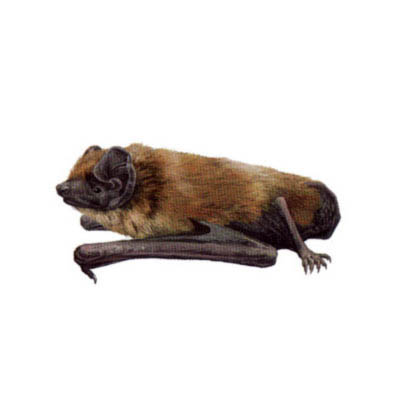
Nyctalus noctula (Schreber, 1774)
Vespertilionidae
Least Concern
| Other names | |
|---|---|
| Catalan | Nòctul gros |
| Spanish | Nóctulo mediano |
| English | Noctule bat |
| French | Noctule commune |
| Basque | Gau-saguzar arrunt |
| Galician | Morcego ruivo |
Description
A large-sized bat, with a total body length ranging from 60 to 85 mm, a forearm length between 46 and 58 mm, wingspan between 320 and 440 mm, a tail that can measure between 40 and 60 mm, and a weight ranging from 21 to 30 g. Like all noctules, it has relatively short (15-21 mm) and rounded ears, a rounded kidney or mushroom-shaped tragus, and a short, robust snout. The skin is usually dark brown, although lighter around the eyes and at the base of the ears. The fur is long and shiny, with golden-brown tones, and uniformly colored dorsally and ventrally. The wings are long and narrow, allowing for fast flight.
It does not overlap in size with any other European noctule, making it easily identifiable.
Fotografies
Distribution
It is found throughout almost all of Europe and, locally, in the Middle East, reaching to the center of Russia, crossing the Urals and the Caucasus into Central Asia. It can also be found in Oman, from Turkey to Israel, in the east of Turkmenistan, the east of Kazakhstan, Uzbekistan, Kyrgyzstan, Tajikistan, and southeast Siberia. In the north, it reaches the south of Scotland and the south of Scandinavia. It usually breeds in northeastern Europe and mates and hibernates in the southwest.
Roosts and phenology
As summer roosts, they usually choose woodpecker holes and, more rarely, natural tree cavities. These roosts are usually at a height between 4 and 30 meters, typically around 19 meters. The trees are usually ash, willow, beech, oak, alder, or poplar, avoiding conifers. South of their breeding area, colonies can form in buildings, under roofs, and in caves. Similarly, males form summer colonies in tree holes, rock crevices, or buildings. Breeding colonies usually consist of about 20-60 females, while males form smaller groups of up to 20 animals. The offspring (usually one or two) are born in mid-June and July. Juveniles are usually independent after 3 or 4 weeks.
It is a long-distance migratory species, making significant movements from breeding shelters in Northeast Europe to winter shelters in the Southwest. They can migrate over distances of more than 1,000 km and sometimes can be seen migrating during the day along with swallows and swifts. The record distance is 1,546 km. Males occupy mating roosts in early August, from which they sing to attract 4 to 5 females in their harems, although they can attract up to 20 females. In winter, colonies are usually much larger. In trees, colonies typically consist of 100 to 200 animals, with peaks of 420. In buildings, winter concentrations of 500 individuals have been found, while in rock crevices and under bridges in southeastern Europe, thousands of hibernating individuals have been found, usually sharing shelters with other species such as Daubenton's bat (Myotis daubentonii), Nathusius' pipistrelle (Pipistrellus nathusii), and the greater noctule (Nyctalus lasiopterus).
Habitat and diet
It is usually a fairly forest-dwelling species of lowland areas, although it has also been found up to 2,000 meters in altitude. In addition to riparian forests, temperate beech forests, and Mediterranean oak groves, it also uses a wide range of habitats such as wetlands, open areas like pastures and cities, the later as long as there is a minimum tree cover or a high density of flying insects. As hunting habitats, it utilizes a wide range of landscapes, although it seems to avoid coniferous forests and prefers riparian forests.
The diet of this species consists mainly of medium and small-sized diptera, hemiptera, trichoptera, beetles, and moths. It takes advantage of large concentrations of insects over bodies of water, especially in the fall when it begins to hunt before it gets dark, targeting mayflies, ants, and hoverflies. Flight is fast and direct, reaching up to 50 km/h, usually at altitudes between 10 and 50 meters, although it can reach hundreds of meters. It feeds over bodies of water, meadows, and also by hunting insects attracted by street lighting, always maintaining a distance of a few meters from the nearest vegetation.
Echolocation
This species varies its echolocation calls significantly depending on the hunting habitat, although they always consist of a first frequency-modulated (FM) component and a second almost-constant frequency (QCF) component. In closed spaces, the FM component dominates, with peak frequencies between 22-29 kHz, while in open spaces, the calls are usually completely QCF, with frequencies between 17-22 kHz. In open spaces, an alternation of calls at different frequencies can sometimes be observed, although it is not always noticeable. Since the calls are very similar to those of other European species, it is included in the phonic group Eptesicus/Nyctalus/Vespertilio.
Status
According to the IUCN Red List, this species is considered Least Concern, with an uncertain population trend. It is protected by various national laws, Eurobats Agreement, the Bern Convention, and the European Habitats and Species Directive. The main threats to this species include the loss of roosts due to deforestation and building renovation, the loss of hunting habitats due to the degradation of riverine ecosystems, and collision with wind turbines during the migration season.
